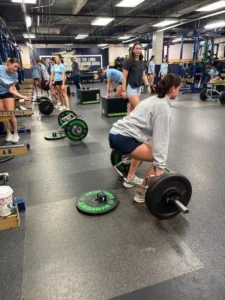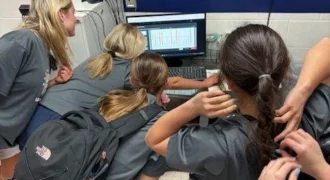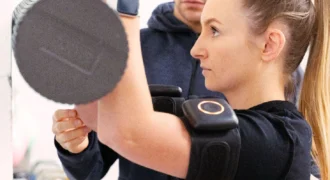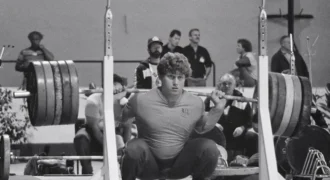Introduction
The days of picking up heavy metal objects and putting them down are quickly devolving into the past. In its vacancy a newer model of using science and technology to maximize human physiology is growing. I am one of the first to admit in my early years I strongly believed that being stronger makes you faster or more explosive. Now that I have been in the strength and conditioning space as an athlete and now coach for almost 30 years my perspectives have completely changed. While those principles that were ingrained in my youth as an athlete and a novice in the profession hold true. The science of maximizing them, and new technology has shown the processes to be far different. I believe the notion of working harder than your competition is being replaced with working harder AND smarter than your competition.
One concept that has evolved for me personally and my program that I support is the transition from “Strength and Conditioning” to “Performance” mindspace. While ultimately the implementation of the program is the same, the processes behind designing the program and its active ingredients are different.
Strength and Conditioning is a science-based approach that uses specific exercises, including resistance training, cardio, and plyometrics, to improve physical performance qualities like strength, power, endurance, and agility, while also reducing injury risk. It relies heavily on programming and goal making and attainment.
Whereas Performance Training is defined as a structured, personalized approach designed to improve an athlete’s physical capabilities and sport-specific skills to enhance their overall ability to compete in their chosen sport. Both have many overlaps, but in our space and setting I believe the semi-personalized and sport specific components are a keynote difference. It takes the foundation of the previous thought processes and systems and expands on them in detail and grows them exponentially. Performance Training, when done well, sits on the shoulder of the Strength and Conditioning Titan.
In making this conceptual transition, here are 10 tips that I recommend making your transition easier and bullet proof for future evolutions. Many of these lessons don’t necessarily have a “recipe” or a formula for success. But rather there are processes or active ingredients that evolve together to achieve success. That is, however, you operationally define success in your respective setting(s).
Involve Sports Science
This one is huge and arguably one of the most important of the thoughts I can offer you. Sports Science is a multidisciplinary field applying scientific principles to understand and improve human performance in sport, exercise, and physical activity. It integrates various disciplines such as physiology, biomechanics, psychology, and nutrition to analyze how the body responds to exercise and optimize training, prevent injuries, and enhance overall athletic performance and well-being. This directly supports the definition of Performance Training. Another positive to include a strong sports science component with the model to grow is that it makes many of the following points more achievable. Sports science offers a perfect set of outside eyes that helps keep you on track, identifies weaknesses to improve, identifies strengths to reinforce, and to offer novel thoughts and processes to improve your program’s product for your population(s). To this point the easy track is to hire a Sports Scientist. Ideally in a full-time capacity. However, that’s not feasible in most situations. My solution was to engage one in a part time consulting capacity, then my position evolved into a sport science position. Ultimately everyone’s needs and values are different. A part time consultant may be your answer, a full-time person with a slew of interns may be your answer. Regardless, engaging a specialist in the setting to at least get eyes on your program and to identify some things that you may not be seeing can be monumental in your program’s development.
Use Technology, but Don’t Let it be Your Foundation
This one is almost literally growing by the day. If you would have told me 10 years ago that we would measure nearly all aspects of our athlete’s performance I would have called you crazy. If you would have told me that we would use VALD Force Decks to identify imbalances, Vitruve to measure effort and objectively assess performance in the weight room, DASHr lasers to measure sprints, runs, and agility drills, GPS units to measure every step our athletes have on their field, and technology that does a 24/7 measurement of heart rate, and heart rate variability of our athletes iPads at each rack and work station for easy online programming, and a RockDaisy Athlete Management System (AMS) to visualize it all in one platform; I would have called you insane. However, as robust as our technology is. To make a successful transition from S&C to Performance model don’t lose perspective that you are dealing with humans, not robots or textbooks. We are working (in my primary setting specifically) with 12–18-year-olds with emotions, real-world problems, pressures of society, and expectations of all shapes and sizes. How I handle my Olympians and private clients are completely different from how I handle my youth athletes. However, having the ability to online correct and to connect will take you further than any piece of technology ever will – regardless of who you’re working with. I double down on the notion that the foundations of coaching are emotional intelligence, ability to connect to the clientele, programming/timing of stimuli, and the ability to see the big picture of the program instead of emphasizing individual nuances.
The foundations of coaching are emotional intelligence, ability to connect to the clientele, programming/timing of stimuli, and the ability to see the big picture of the program, says @KyleSouthall1 and @phoebegreene77
Share on X

Image: Volleyball players using Vitruve VBT in their workouts proctored by Sports Science and Performance Intern Phoebe Greene with Head Coach Chris Camper in the background.
Measure Objectively, but Don’t Underestimate Subjective
This ties in closely with point 2. The number of technologies to objectively measure performance have grown exponentially in recent decades. Not only is technology to measure aspects objectively growing, but the quality of these technologies is exceptional, and getting better by the day. The classic example for us is hand timing vs laser timing. Hand timing a 40-yard sprint can have a variability of up to .2-.3 seconds. While that’s not far off – in our world those fractions are massive. The exact same run measured with lasers has a variability of .05-.08 seconds – exponentially more accurate!
While this is important, be sure to keep the real things real. These athletes are real people with real problems. Maybe they didn’t get a good night’s sleep studying for a test, maybe they are distracted from an interaction they had with a friend or teacher, maybe they are struggling with issues at home. Getting so centered on technology and being peak all the time misses the entire human element. Build trust with the athlete and ask the right questions, or at least have the emotional intelligence to be aware of the athlete’s mind space and know that they may not be at their peak today, and that’s OK. Having the ability to online correct and connect will take you further than any measurement ever will – regardless of who you’re working with.

Image: One of our Sports Science and Performance Interns proctoring an athlete doing rehab. Here we are measuring limb symmetry and endurance with Bulgarian squats and Virtuve Velocity Based Training.
Develop a Strong Internship Program
This is the “if you build it, they will come” part of this article. While technology, social media, hype, etc. are all cool, the best marketing is simply doing great work consistently. Ross Garner wrote it well in his article Building an Internship Program with an Eye for the Future of S&C. While this is our world, I think one thing that we do that has helped us exponentially is expand the internship program beyond strength and conditioning interns. What I mean by that is; include interns from sports medicine, kinesiology, nutrition, engineering, and data analytics professions. Also, don’t limit yourself to a demographic. While local talent is exponentially easier to recruit and far cheaper, if you can build a model for students and interns from other regions and disciplines, they will make your program better, especially if you follow the guidance from Ross in the previously referenced article. Once you’ve done this – put them to work. Not simply with the work that you don’t want or don’t have the time to do, but to work! Give them ownership of a portion of the program. Let them coach, let them program, let them learn from their mistakes and grow into meaningful members of the staff.

Image: Two interns in our program. Sports Science and Performance Intern Phoebe Green piloting a new Global Positioning System technology while Sports Medicine Intern Laurel Gomersal.
Make Connections within the Profession
Makes sense right? I thought so, but the longer I am in the profession the more I see this being a missing piece to many programs. There are more programs in silos than I ever imagined. Not that that is necessarily a problem in the cross-section in time, but in the long run it is a very dangerous place. It’s very easy to get into a groove and default to old habits when you have no comparator and no others to challenge you or expand your thought processes. This also goes beyond social media. Is that a start, yes. Is that an important aspect, yes. Is it the final product or landing point, most definitely not. The landing point on this one is developing a network of those around you with a similar mission, but different perspectives on how to accomplish the mission. They can be mentors, peers, or both. The number of times I have identified a problem, or gap in knowledge and instead of having to labor to figure it out myself – I call or text a peer and have an immediate solution or process to get to a solution saving hours or days in efforts (that I could then save and use in other fashions) has been irreplaceable.
Make Connections Between Professions
Coming from an athletic training and sports medicine background, then into the performance world, then wanting to learn the scientific method while challenging myself further in taking on the PhD process I find this especially important. Especially as the move to make both programs integrate into one, into a united flagship program. Inter-professional relationships are the pinnacle to “Building a One Stop Shop for Athlete Performance and Wellbeing.” When the mission is to provide an elite service to our population to maximize their performance while minimizing time-loss injuries, one cannot do it alone. It takes a village within the walls, and an extensive network outside of the walls to do it to a successful level.
When the mission is to provide an elite service to our population to maximize their performance while minimizing time-loss injuries, one cannot do it alone, says @KyleSouthall1 and @phoebegreene77
Share on X
Put Resources Where Your Values Are
This one is contextual, of course. So many times, I see programs getting technology appearing to get technology, or tools without the proper infrastructure or support system to maximize their effectiveness. Before buying any tool, technology, or training programming I ask these four questions:
Does it support our program’s mission and vision?
If it does not, then you should move past. Nothing is more pinnacle than the mission and the vision of your program.
Is there a more fiscally responsible way to implement the same or a similar aspect to what this technology or tool will?
If there is, pursue that other way. If there’s not – test the technology or tool maximally before going all in. This could be a trial, testimonials from those in your networks, etc.
Do we have the resources (time and personnel) to fully implement this technology or tool?
If not, say no more – move on. If so, go all in pending, the other answers fall in line. If somewhere in the middle, identify what does need to happen to have the resources to fully implement (alter times or personnel workloads).
Is there a safer or more efficient way to implement the same, or similar, technology or tool?
If so, explore that other option. If not, go forward with the tool or technology in question.
For us, all questions must be answered appropriately before we move forward. There are few worse things than spending money (someone else’s money) on something then not using it, or it becomes a burden, or finding out you made a bad purchase because you were not fully informed.

Image: Emphasizing recovery. These are two injured football players utilizing FireFly Units to aid in their recovery.
Develop the Ability to Raise Funds, and Build an Environment That it is Positive
Money is always a topic of discussion and there never seems to be enough of it. If there is, let me know and I’ll help you fix that “problem.” Creating a relationship with your administration is a great first step. Then growing into a model where if you raise X amount of money, then you get to keep X amount for whatever you need. In our instance if I raise X amount of money, I get to keep Y (about 10% less) amount for whatever I am working towards. It’s a great model and has been very successful. I have two living lists. One that is a list of “wants/needs” and their values. I do this because if a donor or booster ever comes to us and says we have X amount of money and we want to give it to your program I can immediately tell them what we would use it on. The second is a list of entities I would approach if a need arose. Most recently, for example, we have an intern whose work was accepted to present at an international conference. She needed assistance to offset travel expenses, so I approached a contact, gave them the story, and 2 hours later we were getting lunch and transfer of funds. While this sounds easy – it has taken years of networking, building relationships, and emotional intelligence to get to this level. I have “tiers” within this list. If we need hundreds of dollars this is the list of who we would approach, if we needed thousands, here is the list of who we would approach, and if we need many thousands here is who we would approach. One thing to keep in mind is to have support for your request, and you can only go to the well so many times before it is dry. I recommend starting with a meeting with your administration to clearly outline the rules of engagement at your institution and get them in writing. Once you have that, start brainstorming by seeing what others are doing. Don’t try to re-invent the wheel here. Find someone who is already doing it well and take what they do, fit it into the context of your fundraising rules, then adapt accordingly, building in ways for it to grow in the future. Sustainability and the ability to grow is pinnacle!
For me specifically I meet with my administration almost monthly (sometimes more often) on administrative aspects of our program. I’ve been given our rules on raising funds. For us it boils down to we are given X amount in our budget. Anything beyond that I must get Boosters to agree to fund or go source funding to cover the difference. I typically do this via local contacts that I have built over the years or grants; both scholarly and company based. For example – Blue Cross Blue Shield has a nutrition-based program in nearly every state. Here is an example for our Blue Cross Blue Shield Be Healthy School Grant in Alabama. Start small and build up. If writing is not your thing, engage someone in your network or as a consultant to help!

Image: An example of utilizing an unused space. This is an old concession stand that we remodeled into a nutrition room in our athletics wing. It has two refrigerators, freezer, sink, and lots of cabinet space for storage.
Spread Knowledge
I did not appreciate this one as much as I should have early in my career, and I have probably over corrected in this area in the cross-section in time of my professional journey now. I also firmly believe that this is the area that supports building a network more than any other. While I am PhD trained, I chose to get out of academia in the notion that this was overemphasized at the institutions I was associated with in this area in the respect of “publish or perish.” I take it more to a notion of what I can do to help professionals be more professional, people be more productive, and to make the profession better than how I found it. I also think this is an awesome way to get students and interns to buy into the program. Each intern we have develops and implements a project. This may be a case study, maybe a non-peer reviewed article, or an international presentation, or anything in between. The moral of the project is to put their stamp on our program and be an active ingredient in its growth, while they grow personally, professionally, and spiritually.

Image: Spreading knowledge at the Isokinetic Injuries in Football Conference in Madrid, Spain 2025.
Adopt an “I get to” not an “I Have to” Mindset
Here is where we get philosophical. I believe that to be a keystone to our program. As it evolves putting people in positions to be successful and recruiting the next generation of professionals in due time. In the hustle and bustle of our current society in the professional world it’s very easy to get overwhelmed, burned out, jaded, or “paralysis by analysis.” One thing that has helped me and has been very impactful by encouraging our staff and interns is this principle. When you have a mindset of “I have to get up early to do X,” or I “have to put up with Y group/class/person, “or I have to go to Z meeting” it is very easy to connotate them in a negative stance, which only snowballs. When you learn to adopt a “I get to” attitude, the same task becomes more clear, achievable, and valuable. And ultimately that’s what most, if not all, people want – to feel valued and important. I get to get up early to help our volleyball team get better, because I am the best person for the job and they have a need for my skills that I can fulfill. I get to work with Y class/team/person, so that I can mentor them and guide them to be a better person, leader in the community, family, husband, wife, father, mother, etc. maybe in the process I can become more patient and understanding. I get to go to Z meeting because they want or need my input, and the action items that come from that meeting are best implemented by me, or my team. A simple mindset adjustment can change your perspective and direction.
11 – Bonus Point! Top 5 Values that I Valued in Our Strength and Conditioning Program vs. What I Value Now in Our Performance Program

Chart: Comparison of what things are valued in a Strength and Conditioning Program vs. in a Performance Program
Conclusion
In summary, is making the paradigm shift from Strength and Conditioning towards Performance training a major shift? Maybe. I do strongly believe it’s a (growth) mindset over tangible outcomes. I’d argue that the strength and conditioning programs that do their role(s) really well embrace the performance training concept more than they think. As with many aspects of our profession, it’s acknowledging and embracing that it is a process towards perfection more than a product or perfection. Especially for those in it for the long game. Having the ability to harness the science and embrace the art of maximizing performance while minimizing time loss has the edge over those who are not in the long run.
The post 10 Tips to Evolve Your Strength and Conditioning Program into a Performance Program appeared first on SimpliFaster.







